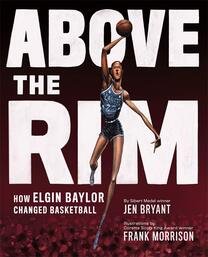It’s a Slam Dunk! Aiming High with Jen Bryant’s Above the Rim: How Elgin Baylor Changed Basketball5/11/2021
By Donna Sabis-Burns and Amina Chaudhri, on behalf of The Biography Clearinghouse
Please visit The Biography Clearinghouse for an interview with Jen Bryant and a range of critical teaching and learning experiences to use with Above the Rim. Highlighted here are a few teaching ideas inspired by Above the Rim. The full book entry is available at the Biography Clearinghouse. Literary and Figurative Language Jen Bryant wrote Above the Rim in prose verse - a form of writing that does not use a rhyme scheme or rhythm but is formatted to look distinctive on the page, and makes use of word and line spacing to create an effect. The reader must carefully follow the punctuation in order to read prose verse fluently rather than pausing at the end of each line. This form also allows the writer to isolate particular sentences, placing them on lines of their own, which can serve to call attention to them. Bryant does a beautiful job in capturing the rich emotion of Elgin Baylor through careful word choice and line spacing.
Analyzing Character In her interview, Jen Bryant frames her work as a writer with a quote from the poet, Nikki Giovanni: "Writers don't write from experience, they write from empathy." She adds that she hopes her readers will empathize with Elgin Baylor and understand him in the context of his environment. Above the Rim characterizes Elgin as persistent, humble, brave, and more and as such, can be used to teach about character traits using text evidence.
Donna Sabis-Burns, Ph.D., an enrolled citizen of the Upper Mohawk-Turtle Clan, is a Group Leader in the Office of Indian Education at the U.S. Department of Education* in Washington, D.C. She is a Board Member (2020-2022) with the Children's Literature Assembly, Co-Chair of the 2021 CLA Breakfast meeting (NCTE), and Co-Chair of the Diversity, Equity and Inclusivity Committee at CLA.
Amina Chaudhri is an associate professor at Northeastern Illinois University in Chicago, where she teaches courses in children's literature, literacy, and social studies. She is a reviewer for Booklist and a former committee member of NCTE's Orbis Pictus Award for Outstanding Nonfiction for Children. *The views expressed herein do not necessarily represent the positions or policies of the U.S. Department of Education. No official endorsement by the U.S. Department of Education of any product, commodity, service, or enterprise mentioned herein is intended or should be inferred. Comments are closed.
|
Authors:
|
CLA
About CLA
|
Journal of Children's Literature
Write for JCL
|
ResourcesCLA-sponsored NCTE Position Statements
|
Members-Only Content
CLA Video Library
|
© COPYRIGHT 2018.
ALL RIGHTS RESERVED |


 RSS Feed
RSS Feed